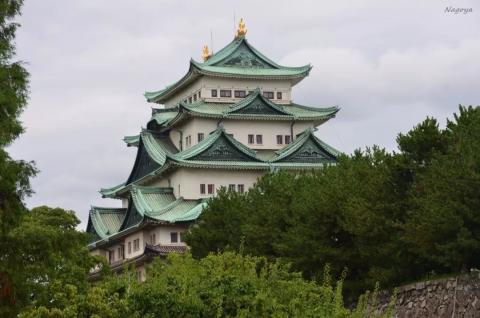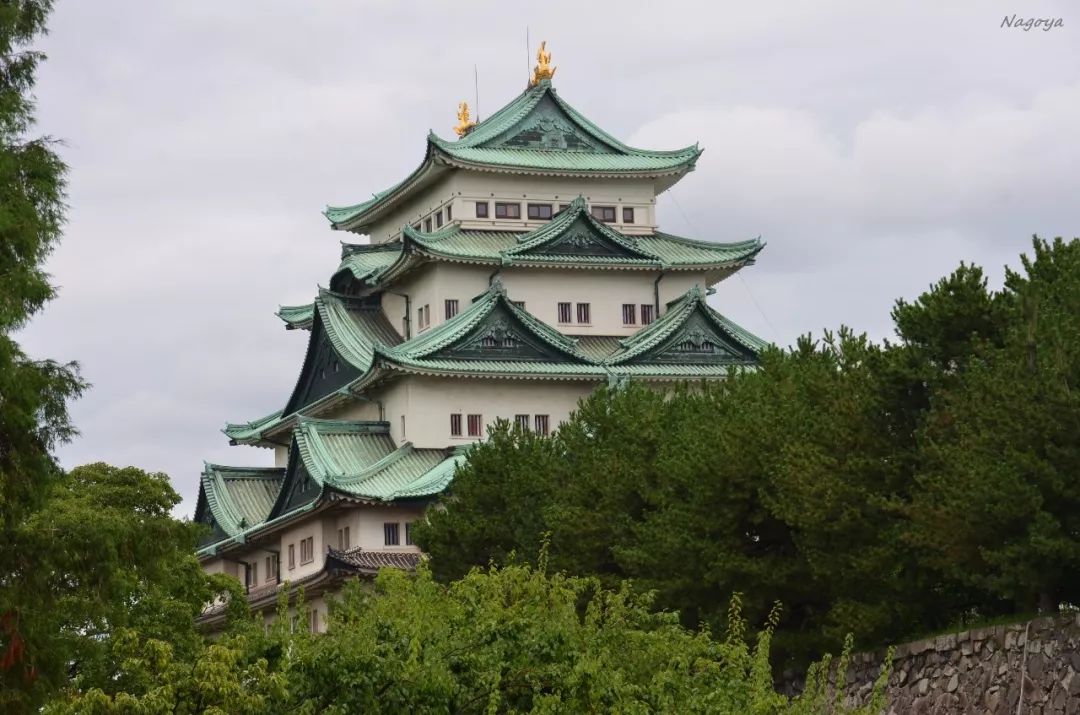
The last time I came to Japan was New Year's Day, which coincided with the Japanese celebrating the most solemn festival of the year, and also coincided with people all over the world celebrating New Year's Day, so that every tourist attraction in Japan I saw was packed with people, especially places like Kasuga Taisha Shrine. , Fushimi Inari Taisha, a famous shrine, where even locals flocked to worship the gods and pray for blessings. A somewhat boring attraction like Osaka Castle also instantly became a hit, so I was really waiting in line until I collapsed. When I saw The team reflexively wanted to go over and get in line. But this time when I came during a non-holiday, there was not much queue whether it was for meals or sightseeing, which I still couldn’t get used to. I don’t know if Nagoya itself is not as large and famous as Kyoto or Osaka, so there are relatively few locals and foreign tourists.
When I came to Japan this time, I saw more of the Japanese people’s working conditions in Nagoya. On Monday morning, Xiao Yu was not absent from Nagoya, which is in the rainy season. Most of the streets were filled with Japanese people holding umbrellas and walking hurriedly to work. It was rare to walk aimlessly like me. Then I made two interesting discoveries. First, they mostly use straight-handled umbrellas, which is completely different from the folding umbrellas that most of us Chinese use. I checked some information. Because Japan is rainy, on average each Japanese person owns more than one umbrella, and one of them must be a long-handled umbrella. The first advantage of a long-handled umbrella is that it will not cause trouble to other people. When you put the umbrella away, the remaining water on the umbrella will flow to the ground along the tip of the umbrella, while a folding umbrella may Splatter on the people next to you. Japanese people are very careful not to cause trouble to others and not to affect other people because of themselves. Long-handled umbrellas may be an example. The second advantage of a long-handled umbrella is that the ribs are strong. Because Japan sometimes has strong winds and rains, there are still certain requirements for the strength and durability of umbrellas, so a strong long-handled umbrella is better than a fragile folding umbrella. Advantage. I see that there are actually Chinese people buying Japanese long-handled umbrellas and shipping them back. (The fourth season of "Round Table" has an episode dedicated to Japanese culture, and long-handled umbrellas are also mentioned in it)
The second interesting discovery is the Japanese clothing style and color preferences. MUJI’s colors and styles are basically the perfect reflection of Japanese clothing characteristics, especially the color. I even have the illusion that every Japanese on the street buys clothes from Muji or Uniqlo. Black, white and gray are almost 80% of the clothing and bags you can see on the street. color, both male and female. If men’s workplace attire cannot break through the two colors of black and white, women’s clothing here does not have any beautiful colors. The colors on their bodies are not richer than those of men. Unlike in China, there is always a touch of color in office buildings. Beautiful colors (but maybe Japanese office buildings also have beautiful colors, but I didn’t see them on the street). I now feel that an Anello backpack or other solid-color canvas bag, a pure white T-shirt from MUJI, and a heather gray or dark blue Uniqlo knee-length skirt can be used without any violation. Japanese streets.
Japan is always orderly, clean, and quiet. Even on a rainy day like this, nothing seems to affect the Japanese people's rhythm of keeping everything running normally. I can't help but compare the scenes I might see on the streets of China in my mind. There will be traffic jams on rainy days, and the car horns will be honking noisily, which reflects the driver's irritability in the face of congestion. It also reflects the eagerness of the people on board to rush for time; Occasionally, on non-congested stretches of road, cars speed by and splash a splash of water, causing pedestrians on the roadside to curse. The subway is not more harmonious than this scene. Chinese people speak loudly (I do the same, my voice rises when I get excited), chatting, quarreling, and showing videos. Although it is crowded, You have to be careful to avoid the dripping umbrellas around you. The chaos and noise are as lively as a wet market.
Finally, I saw someone in the group sharing their feelings about traveling in Japan. The general meaning is: Japan may be the most peaceful and prosperous place in the world. There are no violent protests, no school shootings, no terrorist attacks, and the people live and work in peace and contentment. Prices are ridiculously low (relative to their income), park restaurants can be found everywhere, people respond in an orderly manner when a storm passes, and Fengheli Street is still bustling with people the next day. It is difficult for you to connect this place with the bloody empire and the arrogant people during World War II. But another friend said that this subjective personal feeling does not have any clear meaning. If an ordinary American, European, or Japanese travels to China at this time, he can also feel that Chinese society is comfortable, peaceful, and peaceful. People are busy with their own affairs, and society is running completely on the normal track. Who would have known that China is facing the most serious trade conflict or even national conflict with the United States in history at this moment. He also added that he stayed in Hong Kong a week after the attack on the Sha Tin police in Hong Kong, and what he saw was that everything was going on normally. The book fair was crowded, the shopping mall was still bustling, and the service was as considerate as ever. If not Looking at the Internet, one would not have guessed that Hong Kong is undergoing large-scale demonstrations and protests that are attracting worldwide attention. So, what can we see, and what conclusions should we draw? After thinking about it repeatedly, I think the first one is not to jump to conclusions casually. If you draw a conclusion, you can give a probability; secondly, I feel that what you see intuitively is not important, the relevant statistics are more meaningful, because Only statistics will give you a big picture.
Above, what I saw and heard during my short trip to Nagoya.




I don’t know what Japanese celebrity I met, and a group of fans were taking pictures around it. I don’t care, I’ll take a picture first.









My flight was at 12 noon, and I had nothing to do in the morning, so I walked in the rain to the center of Nagoya city near Nagoya JR Station.



Transparent and black account for 90% of the colors of Japanese umbrellas








Japanese drugstores are the most familiar to Chinese people. According to my price comparison experience during my two trips to Japan, Dakoku Drugstore can beat other drugstores at low prices in the Kansai and Nagoya areas. However, the number of Daikoku stores in Nagoya is very limited, far less than in the Kansai area where one store is only a few hundred meters away, and the product categories are not complete enough. Search Alipay or Dianping. Now they often have coupons from major countries. Don Quijote has more stores in the Nagoya area and a wider variety of products, but the prices are not as cheap as those in larger countries. Matsumoto Kiyoshi has never had an advantage in price, whether in Kansai or Nagoya.

The center of Nagoya – JR Central Tower, is not only Nagoya’s transportation hub, but also Nagoya’s shopping destination, including Takashimaya, Meitetsu Department Store, Midland Square, Kintetsu Passe, Labi, etc.

After seeing this ad, I also bought Ota Wei San

I'm really impressed by the Japanese people's meticulousness towards toilets.

When did this kind of squatting become Japanese style?

Looking at the picture, it looks like an Internet cafe with a personal space, but the word "happy" attracted me
I'd rather go to Japan if I don't want to eat some beef. The beef tastes really soft and tender, which I have never experienced before eating beef, but I always worry that it is undercooked. My friends always say that it is tender, not undercooked. I thought to myself that the difference between tenderness and undercooking is too difficult to grasp and judge. A country bumpkin like me would rather be older than undercooked. The first piece was fresh and even surprising. The second piece felt good. The third piece continued to be good but a little greasy. Why was the fourth piece so greasy? The sauce couldn't be suppressed anymore and it was greasy. I had to eat some vegetables to squeeze it down. That's it, the fifth piece is just barely holding on.
My friend and I told him that a plate costs about 600 to 700. My foodie friend said it’s a very good deal, and it’s definitely more expensive than this in China. I have never eaten it in China and don’t know the market, but if it is so expensive, I probably won’t eat it. I'm only interested in high-quality and cheap dishes like scrambled eggs with tomatoes, chicken stewed with mushrooms, and spicy and sour shredded potatoes.
There are also some other experiences of eating in Japan: ramen is really very salty. I have eaten a lot of ramen and every one of them is salty. You have to be prepared to drink a lot of water after eating the noodles; eel rice is not light and even a bit greasy. Especially the large pieces of fish skin; sometimes the ramen set is a portion of noodles and a small bowl of fried rice. The two staple foods are paired together, but there are no vegetables. This is also very helpless; there is no oden in summer, and oden is my favorite The food I relied on the last time I came to Japan, I would bring a portion with me every night when I went back to the hotel. This was probably the only time I had the chance to eat vegetables during the day.




Healthy Japanese actually eat fried food


